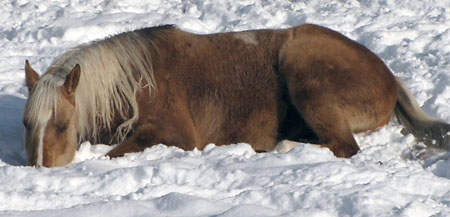home | internet service | web design | business directory | bulletin board | advertise | events calendar | contact | weather | cams

|
Roadside Attraction  The last big dump of snow brought an influx of deer, mostly white tails. Melton says the normally skittish white tails, not native to the valley, "hear the pickup coming and start jumping into the corral." - Photo by Sheela McLean The last big dump of snow brought an influx of deer, mostly white tails. Melton says the normally skittish white tails, not native to the valley, "hear the pickup coming and start jumping into the corral." - Photo by Sheela McLeanIf Winthrop has a signature sight that welcomes tourists and catches the eye of locals year 'round it is Leanna Kumm Melton’s horse corral by the massive willow tree next to the bridge at the south end of town. For more than 30 years Melton, whose grandparents settled here in the early 1920s, has been raising and selling the animals as L.N.D. Quarter Horses. (She's the L in the business. Her daughters Nikki and Deanna account for N and D.) Right now there are a dozen horses in the large corral -- three geldings and nine brood mares, two of which are pregnant. All but the paint gelding are registered quarter horses. She has two stallions in the stud pens -- a palomino and a bay. And she's feeding four horses in the little corrals whose owners will reclaim them come spring. This winter only two mares are pregnant -- the foals are due in April -- because the horse market has been slow. They are not cheap animals to own and as Melton says, when people are struggling to feed themselves, "How can they feed a horse?" Those who ride regularly pay $80 to $100 every six weeks for shoes plus feed and vet bills, she adds. Melton does think the horse market is picking up a little. "There's always been ups and downs," she says and she should know. She's owned horses her whole life and bought her first stud in 1978. "I think it's starting to come back and it seems like there's always a market for good horses." Her goal is to breed a horse with "a very pretty head that's pretty bodied and has good legs" plus a gentle disposition. "Both of the studs we have right now have good dispositions. I wouldn't keep them if they didn't." The babies are easy to sell because they're so cute, she says. The two expected this spring could be sold in the fall just after they're weaned, or as yearlings or two-year-olds. Horses can't be ridden until age two and sometimes people don't want the expense of a horse they can't ride.  Ranger tucks his nose into the fresh snow. The palomino gelding is the son of Justin, one of Leanna Melton's two stallions. - Photo by Karen West. Ranger tucks his nose into the fresh snow. The palomino gelding is the son of Justin, one of Leanna Melton's two stallions. - Photo by Karen West.How many tourists have taken photographs of her animals over the years? There's no way of knowing although she suspects more are taken of the deer than the horses this time of year. If there are disadvantages to having horse corrals so visible from the main highway, Melton doesn't mention any. (Rarely, the animals have to be moved at spring runoff when the river rises enough to flood the low-lying parts of the big corral.) "We've met some wonderful people from it [the corral] being on the road," she says, including a number of people from other countries who barely speak English. "I love meeting people and I really don't care if people go down to see the horses as long as they don't go into the corrals with them." Melton, the daughter of Roy and Doris Kumm, was raised on the same land her grandparents Frank and Lillie Kumm bought at the foot of Lucky Jim Bluff when they moved to the valley in April 1924. And just to show how history repeats itself, according to a story in Methow Valley Pioneers, their mare had a foal within 36 hours of their arrival. 2/6/2012 Comments
|
